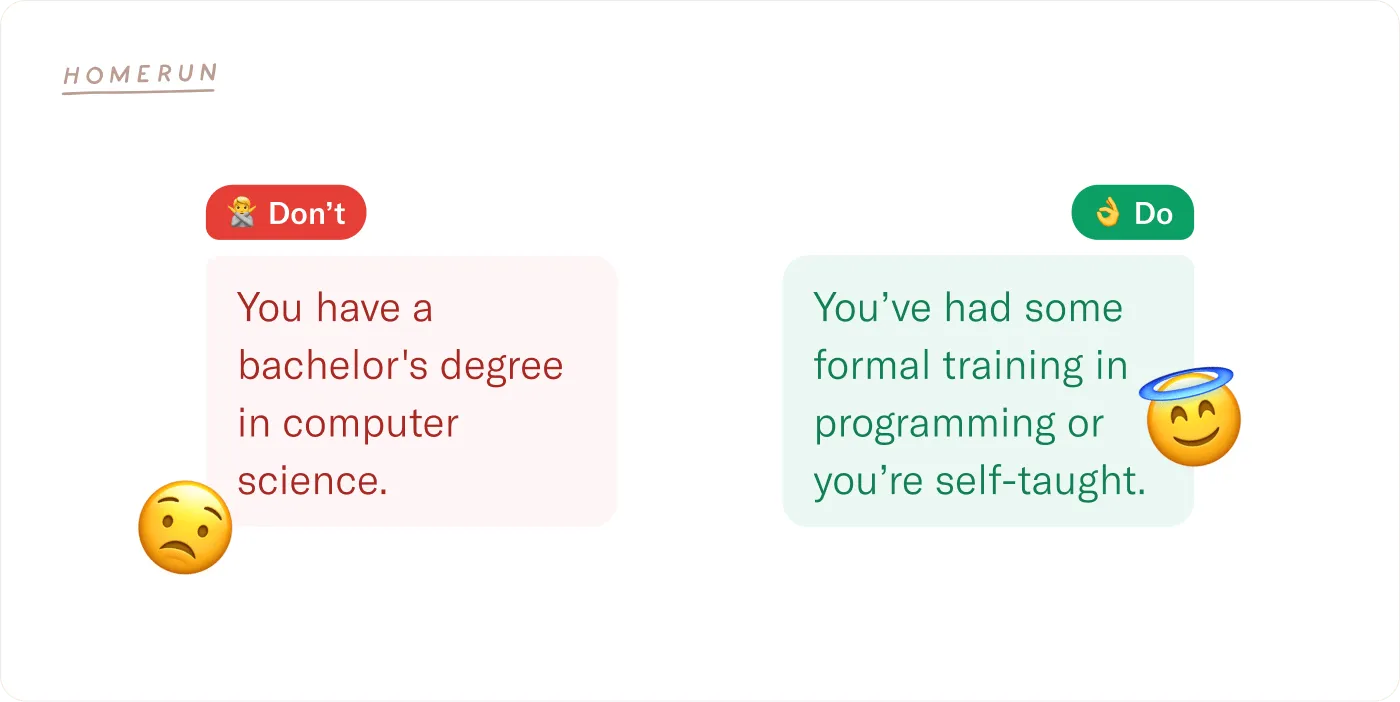
The world of hiring has changed over the years and one of the most positive developments has been an increasing commitment to diversity, equity and inclusion in the workplace.
Employers are realizing that diverse teams perform better and drive more innovation. Not to mention the fact that fostering and nurturing diverse teams is the right thing to do for a more equitable and fair world.
But how do you create a diverse team? Well, that’s a complex puzzle of projects, initiatives and company-wide dedication. In this article we’ll zoom in on one very important piece of that puzzle: utilizing inclusive job descriptions when hiring.
After all, you can’t hire diverse talent if you’re writing job descriptions that are unknowingly deterring people from applying. We’ll dive into examples, general advice and specific tips to follow when writing inclusive job descriptions so that you can attract amazing diverse talent that will thrive at your company.
What is an inclusive job description?
An inclusive job description is one that accurately describes what you’re looking for in a candidate in a way that doesn’t deter qualified candidates from applying for the job. A non-inclusive job description could inadvertently cause potential candidates to conclude that they’re unqualified for the role or unwelcome in your team.
An inclusive job description should show marginalized groups that they’ll be encouraged and supported in this role at your company. That’s why the prerequisite of any inclusive job description is to be an inclusive team, after which you can communicate that to your candidates.
This means going beyond a mere equal opportunity or DE&I statement — you can’t just slap that onto your job description and call it a day. You have to be able to back it up with proof and use language that will resonate with diverse talent throughout the job description. So, let’s get into it.
<div class="inpage-callout-container"><p class="inpage-banner-text">📣 Read more about how to write a job description that attracts talent.</p></div>
How do you ensure a job description is inclusive?
1. Use a job title that candidates will recognize
Research what job title accurately reflects what you’re looking for. Don’t be tempted to go with creative titles like Marketing Hero, Coding Guru or Design Rockstar. Areej AbuAli, the founder of Women in Tech SEO explains, “Using terms like this can deter candidates from applying as it’s empty terminology and quite often associated with a negative workplace.”
<div class="inpage-callout-container"><p class="inpage-banner-text">📣 Find 60+ job description templates to jumpstart your hiring and attract the qualified, diverse talent you need.</p></div>
2. Avoid complex language and industry jargon
Steer clear of using language that people won’t understand if they don’t already work in your industry, especially if industry knowledge isn’t a requirement for the job. Use concise, clear and concrete language to describe the job so that it’s easy to understand what the role entails.

3. Use gender-neutral language
Don’t use the term ‘he/she’ when referring to the person in the role you’re hiring. Instead, talk to your candidates by using ‘you’ as much as you can. It’s much more friendly and personal, and it’s more inclusive towards people who don’t use ‘he’ or ‘she’ pronouns.

4. Balance out gender-coded language
Research shows that some words appeal more to one gender than others, which can result in a skewed pool of applicants. Verify that you have a gender neutral job description by running your text through a tool like the Gender Decoder. You could even consider skewing it more towards one gender for roles in which that gender is typically underrepresented.
5. Emphasize willingness to learn
Consider leaving out any requirements that can be learned within the first months of the job and instead emphasize a willingness to learn. This will lead to a more diverse pool of applicants who have the talent and growth mindset to thrive at your company even if they don’t have the exact skills (yet!).
🎤 Patrick Finley did that beautifully in a job description he wrote back in 2020 when he was hiring a developer for his Y Combinator startup. "My main goal was to create a job post that's as inclusive as possible. I really wanted to make sure no one self-selected out while also attracting the kind of person that would thrive at an early-stage startup.”
Here are some lines from the inclusive job description that explicitly emphasized learning over skills:

6. Boil down requirements to their essence
The tough thing about writing requirements is that the whole point of them is to exclude people that don’t fit the role. But you’ll want to avoid excluding people who would be great for the job, but don’t meet requirements that are too narrowly stated.
So, try and get to the core skills and traits you truly need when listing your requirements to prevent qualified diverse talent from opting out of applying.

7. Be mindful of the different ways language can be interpreted
Some generic phrases that are often used in job descriptions have implicit meanings that signal a non-inclusive company culture with a poor work-life balance.
🎤 According to Tania Doshko from the hiring portal Wikijob, "Words and phrases like ‘energetic,’ ‘dedicated,’ or ‘who can give 110%’ often put additional pressure on candidates. They are automatically interpreted as ‘working long hours’ and ‘overtime’. Thus, candidates with children or single parents are more likely to pass on this job description. Furthermore, the company might create an impression of one with a poor work-life balance so that even young candidates ‘who can give 110%’ would not apply.”
These are just a few examples, but there are a lot more phrases like this that have double meanings. It can help to have a number of people in your team read over your job description (hello, collaborative hiring) and check for this kind of unintentional exclusionary language that signals an unpleasant working environment.

8. Be open to non-traditional paths of education
If you are requiring candidates to have a specific degree, you’re already shrinking your talent pool down to a homogenous group of people which leads to hiring bias.
🎤 Michael Lantry, recruiter at GemPool Recruitment gives a great example of this, "STEM courses are generally male-dominated, which means women candidates are less likely to have a traditional background. So if you require a STEM degree, you’re likely not going to get a very diverse pool of applicants.”

9. Limit the number of requirements listed
Research shows that women are less likely to apply to job posts if they don’t meet 100% of the requirements listed, while men will apply when they meet just 60% of the listed requirements. The fewer requirements you have, the less likely qualified candidates will self-select out of your hiring process. So leave out nice-to-haves and stick to the most important requirements.
Inclusive job description example:
<div class="browser-container"><div class="browser-chrome"><div class="browser-block-buttons"><div class="browser-icon"></div><div class="browser-icon"></div><div class="browser-icon"></div></div></div><img src="https://cdn.prod.website-files.com/5e1452b8eb497cb0d999c76f/64c2882c2e4920b6b57fb6b4_inclusive%20job%20description%20example%20geckoboard.png" loading="lazy" alt="Geckoboard" class="browser-image"></div>
Homerun customer, Geckoboard does a great job at keeping the list of requirements short and sweet while phrasing things in a way that keeps qualified candidate's from opting out of applying.
10. Include a salary indication
According to Tracey Beveridge, the HR Director at Personnel Checks, a job advert should always, always include the salary, or at the very least an idea of the salary range.
Research has shown that showing salary in job posts increases the number of applications from candidates with diverse backgrounds. By not including salary, you are effectively reducing your pool of applicants.
🎤 Areej AbuAli, the founder of Women in Tech SEO agrees. “One of the biggest reasons I see for people self-selecting out of an application process is lack of transparency around salary and benefits. Within the Women in Tech SEO community, we don’t share jobs that don’t include a salary range and language such as ‘competitive salary’ has become a red flag in the industry.”
11. Include information about how accessible your office is
Job posts often include information about the office and how to get there. This is a great place to also mention how accessible the office is for people with disabilities and who may need to use a wheelchair. This is not only good information for candidates to know in order to decide whether they should apply, but it also shows that you’re considerate of team members with different needs.
12. Include information about your hiring process and offer accommodations
It’s always good to include the steps of your hiring process on your job post so that candidates know what they can expect. This is a great place to add that any necessary accommodations can be made for candidates who are neurodivergent and/or have a disability.
For example, someone who is hard of hearing may need to have good lighting in a video call so they can lip read, someone with dyslexia may need more time for assignments and someone with autism may need to be interviewed in a quiet space to avoid sensory overload.
Mentioning that you’re open to accommodating candidates with different needs in your job description will make them feel more welcome to apply. You can even use your job application questions to ask candidates what accommodations they’ll need should they move to the interview process.
Inclusive job description example:
<div class="browser-container"><div class="browser-chrome"><div class="browser-block-buttons"><div class="browser-icon"></div><div class="browser-icon"></div><div class="browser-icon"></div></div></div><img src="https://cdn.prod.website-files.com/5e1452b8eb497cb0d999c76f/64c288d1db33642bc2a757d9_Inclusive%20job%20description%20example%20Homerun.png" loading="lazy" alt="Hiringprocess" class="browser-image"></div>
How you can offer accommodations to candidates in one simple sentence on a job post
<div class="inpage-callout-container"><p class="inpage-banner-text">📣 Use Homerun’s job post software to build job posts that beautifully reflect your company culture.</p></div>
13. Describe the working environment and working arrangements
Candidates who have caregiving responsibilities, have a chronic illness, are neurodivergent and/or have a disability will need to know how flexible a job is. Include information about whether the job is remote, hybrid or in the office, what the office atmosphere is like and whether working hours are fixed or flexible.
🎤 Tracey Beveridge, HR Director at Personnel Checks says, "Most people with caring responsibilities will need to know the degree of flexibility in working patterns available. Many companies are happy to offer this, but because they don’t make it clear at the application stage, people who need it will likely not even apply. All our job adverts link to information about our approach to hybrid and flexible working and give real examples of how this works for current employees.”
14. Include a DE&I statement
Notice how this is the last tip on the list? That’s because it should be obvious that you welcome everyone to apply before candidates even get to the diversity statement. Inclusivity should be the common thread of the entire job description. However, it certainly helps to include an explicit statement.
Be sure to write something authentic and reflective of your company that includes concrete examples of projects and initiatives of how you work towards DE&I. Don’t just add a generic statement like “We welcome everyone with equal enthusiasm – regardless of race, color, age, gender, sexual orientation, nationality or disability.”
Inclusive job description example:
<div class="browser-container"><div class="browser-chrome"><div class="browser-block-buttons"><div class="browser-icon"></div><div class="browser-icon"></div><div class="browser-icon"></div></div></div><img src="https://cdn.prod.website-files.com/5e1452b8eb497cb0d999c76f/64c289e44d0d4f74a6717173_Inclusive%20job%20description%20example%20Homerun%20DEI%20statement.png" loading="lazy" alt="Homerun" class="browser-image"></div>
Homerun's diversity statement
To sum it all up, writing an inclusive job description is no easy task, but follow these tips and you’re bound to show diverse candidates just how inclusive and welcoming your company culture is.
In the end, it’s all about stepping into the shoes of your candidates and seeing how your job description comes across, and doing everything you can to make them feel welcome to apply.
<div data-w-id="52b3c38c-4cb2-182f-70e4-e31cdfd39910" class="cta-container career"><div class="columns-24 w-row"><div class="column-65 w-col w-col-7"><div class="inpage-cta-text-container"><div class="inpage-cta-title">The best-looking career site <span class="enter-responsive">out there (built by you)</span></div><p class="inpage-cta-text p">With an easy no-code builder you can create a custom career page and job posts that perfectly match your brand.<br></p><a target="_blank" href="https://app.homerun.co/register" class="btn-cta career a w-button">Start free trial</a></div></div><div class="column-64 w-col w-col-5"><div class="inpage-cta-image-container"><img src="https://assets.website-files.com/58d684124f3644b01d649b26/646f4947b35f8177a426676c_career-cover-image.png" loading="lazy" height="" width="410" srcset="https://assets.website-files.com/58d684124f3644b01d649b26/646f4947b35f8177a426676c_career-cover-image-p-500.png 500w, https://assets.website-files.com/58d684124f3644b01d649b26/646f4947b35f8177a426676c_career-cover-image-p-800.png 800w, https://assets.website-files.com/58d684124f3644b01d649b26/646f4947b35f8177a426676c_career-cover-image-p-1080.png 1080w, https://assets.website-files.com/58d684124f3644b01d649b26/646f4947b35f8177a426676c_career-cover-image-p-1600.png 1600w, https://assets.website-files.com/58d684124f3644b01d649b26/646f4947b35f8177a426676c_career-cover-image.png 1620w" sizes="(max-width: 479px) 100vw, (max-width: 767px) 75vw, (max-width: 991px) 39vw, (max-width: 1439px) 361.64892578125px, 25vw" alt="" class="cta-image" style="transform: translate3d(0px, 0px, 0px) scale3d(1, 1, 1) rotateX(0deg) rotateY(0deg) rotateZ(3deg) skew(0deg, 0deg); transform-style: preserve-3d;"></div></div></div></div>












.png)

